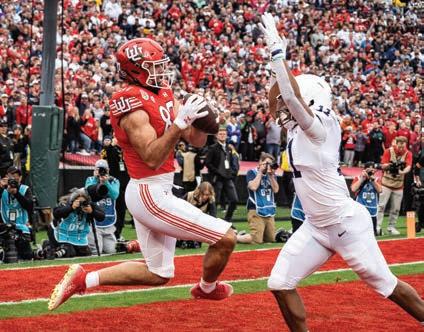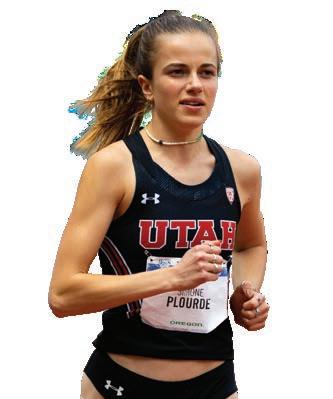
6 minute read
Celebrating 50 Years of Title IX
A scholarship for a local tennis star was the first awarded to a woman student-athlete at the U
At the time, Jane Stratton didn’t realize she was making history. There was no fanfare and no press conference when the tennis star became the first woman to ever receive an athletics scholarship from the U.
It was the mid-1970s, and Title IX, the law prohibiting sex-based discrimination in federally funded education programs, was still in its infancy. The historic scholarship to Stratton came about after a conversation between Irv Stratton, Jane’s father, and then-Utah Athletics Director Bud Jack about scholarships. His daughter, after all, certainly had the credentials—the Highland High graduate was ranked No. 1 in the nation in doubles and fifth in singles.
“I don’t know why Jane doesn’t get a scholarship, because she has accomplished way more than any of the men,” Irv said to Jack. He agreed with the reasoning, and the tennis star was given a scholarship.
Following collegiate success, Stratton turned pro and went on to reach the Wimbledon quarterfinals twice.
Other women’s sports teams incrementally became part of Utah’s Athletics department as scholarship programs when funds became available to elevate them to sufficient levels. The programs include basketball (1974); volleyball (1975); gymnastics, skiing, and softball (1976); cross country/track (1981); swimming and diving (1982); soccer (1995); and beach volleyball (2017). In 2020-21, the university had 229 female athletes. That includes 192 on full or partial scholarships.

“Significant gains have been made, but it’s important, as we reflect on the past 50 years, that we remain mindful of the work that remains ahead of us to enhance and improve opportunities for women in sports,” says Mark Harlan, U Athletics director.
This article was originally published as part of a series reflecting on the 50 years since Title IX was first enacted in 1972. To read the other pieces, visit magazine .utah.edu/titleix.
Sports Briefs
For the second year in a row, the U took the Pac-12 championship and went on to the Rose Bowl. In a matchup between two top 15ranked teams, the No. 11 Penn State Nittany Lions ultimately came out on top, defeating the No. 8 Utah Football team 35-21. The Utes put up a strong fight, finishing the game with 391 yards of total offense, including 207 passing yards and 184 on the ground. However, it was the Nittany Lions’ ability to make chunk plays, averaging 8.3 yards per play on offense and 17.4 yards per completion, that proved to be the deciding factor. In addition to the U team’s impressive performance on the field, U Alumni partnered with Penn State alumni to volunteer at the Los Angeles Regional Food Bank.

In 2022, for the fifth year in a row, at least 93 percent of student-athletes at the U graduated within six years of enrolling. The U is tied for the fourth-highest figure among Power Five public institutions and ties for the sixth-highest score among all institutions at the Power Five level.
Cross country runners Emily Venters and Simone Plourde were named to the All-Pac-12 First Team last fall. Venters, who was also named the Pac12 Scholar-Athlete of the Year, finished second at the Pac-12 Championships, and Plourde came in fifth.

A new Runnin’ Ute and Red Rocks Express is shuttling fans from the Guardsman Way Tailgate Lot and the Broadcast Center Lot on Wasatch Drive for all home men’s basketball games and women’s gymnastics meets. The free service begins about 90 minutes before each scheduled event start and runs as demand warrants, until after each event ends.
In a visit to the Magnolia State, the U women’s basketball team added yet another record to the books in a historic victory over Mississippi Valley. Led by top scorer Alissa Pili, the Utes registered a 109-42 win to secure the largest score differential ever seen in a road game.
Small Town Roots, Big Talent
Kennady “Lightning” McQueen has basketball in her blood. After all, her mother, Melanee Brooks McQueen BS’91, helped the U women’s basketball team win the WAC tournament in 1991. And although the younger McQueen had 25 D1 offers, the three-time all-state pick, Utah Gatorade Player of the Year, and Deseret News Ms. Basketball chose the U.
“I fell in love with basketball at a young age and knew my dream was to follow in my mother’s footsteps,” says Kennady McQueen, who honed her skills through programs like the Nike Elite Youth Basketball League, where she was coached by legendary U basketball star Keith Van Horn ex’97.
Her family members have become regulars at home games, with as many as 20 or 30 watching from the stands as she helped the U start the season with a 14-game winning streak and climb the ranks nationally. “We have a goal of making a run in the NCAA tournament, specifically the Sweet 16,” she adds. “That’s what matters to me and the team at the end of the day.”
HOMETOWN Henefer, Utah
YEAR IN SCHOOL
Junior academically, sophomore on the court
MAJOR Kinesiology POSITION Guard
2021-22 SEASON
Averaged 23.5 minutes, 9.6 points, 3.7 rebounds, and 1.2 assists per game
More Than The Game
Named to the Pac-12 Academic Honor Roll
THREE-POINT QUEEN
Last season, ranked first in the Pac-12 and eighth nationally in three-point field goal percentage, making 44.2 percent of her threes
DEFENSIVE POWERHOUSE
In 2021-22, led the team in steals with 33
FAVORITE FLICK
The Lorax
PODCASTS IN HER QUEUE
Motivational speeches and murder mysteries
PUMP-UP MUSIC SZA, Bazzi, Noah Kahan, Lauv, and occasional rap
MANTRA
TO LIVE BY Dreams don’t work unless you do
FAVORITE RESTAURANT
Larry’s Spring Chicken Inn (Morgan, UT)
Dinos on the Big Scream
Have you ever wondered if Jurassic Park is realistic? Jeff Goldblum’s sexual magnetism is most certainly accurate, but what of the dinosaurs?
Enter Mark Loewen PhD’09, a paleontologist at the Natural History Museum of Utah and associate professor in the Department of Geology and Geophysics at the U. In June, Loewen critiqued the accuracy of Hollywood’s depictions of dinosaurs for Vanity Fair in a video that has racked up more than 3 million views on YouTube.
“I love these movies—some of them are horrible, but I still love them,” says Loewen. And he’s uniquely suited for the job. In the early 2000s, he and his mentor Scott Sampson created a class called World of Dinosaurs, GEO 1040, where students watch movie clips and analyze the veracity of dino representation. He expanded this idea to create Science and Cinema, GEO 1000, a non-majors class that analyzes science in movies. By studying the dinosaurs, natural disasters, and science fiction presented onscreen, students learn fundamentals while having fun celebrating—or berating—various motion pictures.
“I view myself as an evangelist for science,” says Loewen. “Movies are a sneaky way of showing students at the U how cool these concepts are. I mean, isn’t this one of the most awesome classes you could take? Get a credit to watch movies and learn about the science.”
An alum of the Science of Cinema class now works at Vanity Fair and recommended Loewen for the video series, which coincided with the release of Jurassic World Dominion in 2022. A professional film crew shot his interview in the paleontology collections at the museum. If you watch the video closely, you can see specimens of dinosaurs that Loewen himself has discovered and named.
Study Suggests Genes May Play a Major Role in Stillbirth
Nearly 21,000 babies in the United States are stillborn each year—and doctors often can’t explain why. But newly published research may shed some light on one of the causes.
The study is the first to show that stillbirth can be inherited and tends to be passed down through male members of a family. And the odds of a couple losing a baby to stillbirth are greatest when the condition comes from the father’s side of the family.
“Stillbirth is one of those problems that is so tragic and life-changing,” says Jessica Page MS’20, an assistant professor in the Department of Obstetrics & Gynecology at University of Utah Health and Intermountain Healthcare. “This knowledge may give us the opportunity to change how we risk-stratify people and reduce their risk through prevention.”
Page is co-author on the study led by Tsegaselassie Workalemahu and senior author Robert Silver, both of whom are faculty in the Department of Obstetrics & Gynecology at U of U Health.
To understand other risk factors contributing to stillbirth, the scientists examined 9,404 stillbirth cases and 18,808 live birth controls between 1978 and 2019 that were represented in the Utah Population Database, a genealogical resource linked to health, birth, and death records. They found that 390 families had an excess number of stillbirths over multiple generations, suggesting genetic causes of stillbirth.
“Stillbirth rate reduction has been slow in the U.S., and we think many stillbirths may be potentially preventable,” Page says. “This is motivating us to look for those genetic factors so we can achieve more dramatic rate reduction.”









